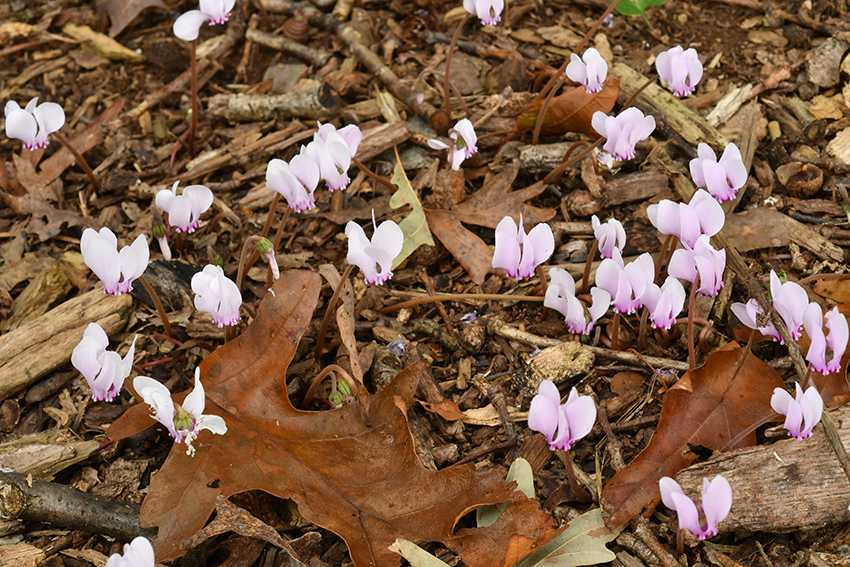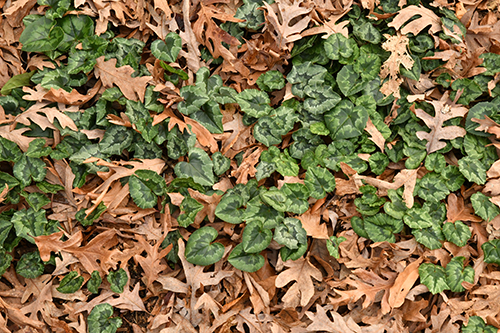
It is amazing how some plants become pigeonholed into specific categories and on occasion, it is difficult for even experienced gardeners to break free of this mindset. Cyclamen is a plant that is most befitting of this conundrum. Most people think of Cyclamen as a somewhat finicky winter blooming houseplant that all too often is overwatered during the summer and perishes. Discouraged, we fail to take notice of the various hardy selections that can provide low maintenance additions to the woodland garden with blossoms during nearly every season!
Cyclamen is a member of the Primulaceae or Primrose Family with 23 species native to Europe south through the Mediterranean and east to the Caucasus and Iran. Cyclamnos was actually the Latin name for the plant, which the Swedish botanist Carl Linnaeus (1707–1778) tweaked to create the genus name in 1753. The name Cyclamen has in roots in the ancient Greek word Kỳklos or Kuklos meaning circle, a reference to the circular tuber from which the plants develop or perhaps the curled floral stems, clearly evident both before and after pollination.
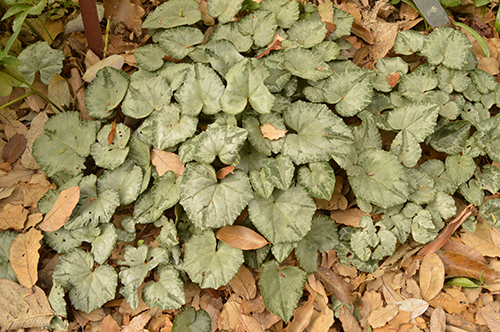
All 23 species of Cyclamen grow from a circular tuber composed of modified stem tissue that allows the plant to endure periods when the climate is not conducive to growth. The tuber originates along the stem-like portion of a seedling called the hypocotyl, which connects the unfurling cotyledons or initial leaves with the roots. Based on where the tuber develops dictates whether it is more like a stem or a root. In other words, if the tuber develops closer to the cotyledons, it will behave more like a stem with the roots developing from the base of the tuber, whereas if it develops closer to the roots, the structure will be less stem-like and roots will appear on the top and side of the tuber. The leaves and flowers always emerge from buds or growing points on the top of the tuber. In some cases, as is typical of Cyclamen purpurascens, the growing points develop into short stems called floral trunks.
Of the hardy selections available, Cyclamen hederifolium is probably the most readily available and easiest species to grow. Named and described by the Scottish botanist William Aiton (1731–1793) in 1789, the species epithet serves to describe the foliage, as Hedra is from the Latin for ivy and Folium for leaf. The foliage does indeed resemble that of English Ivy (as seen in Picture 1) with the heart shaped leaves most often having the characteristic lobes on either side of the leaf. The foliage color is often a dynamic mottling of dark green and silver, although in some forms the silver coalesces into a pronounced central blotch or entirely covers the leaf as is seen in 'Ashwood Nurseries Silver' (Picture 2).
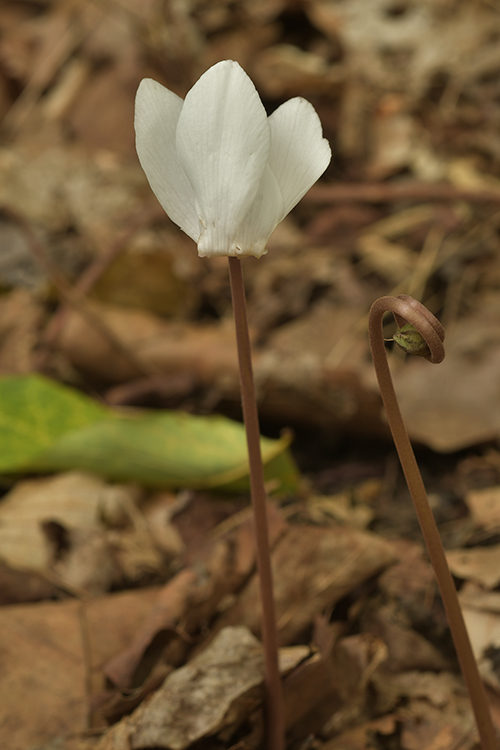
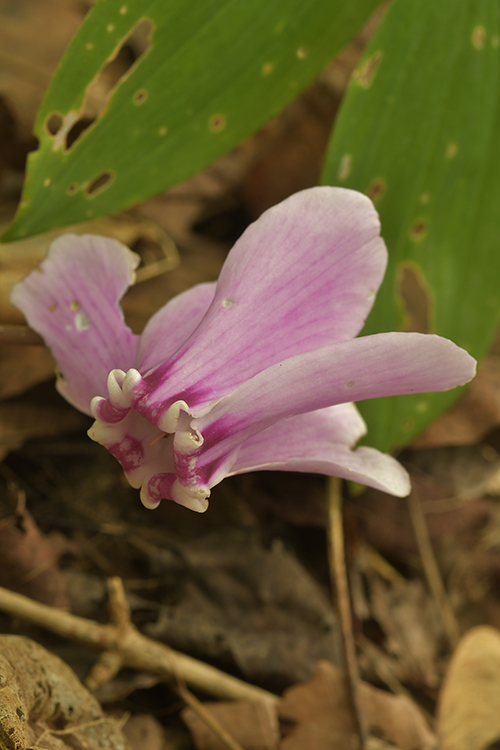
Typical to the genus, the flowers have five petals that are attached to the rim of an inverted cup containing one female style and five male stamens. The flower stems or peduncles initially appear as coiled springs perched atop the ground and the process of flowering and setting seed is an interesting dance as the stems uncoil and subsequently recoil! Starting the dance, the spring-like peduncle slowly uncoils upward in a counterclockwise rotation until reaching its full height of 4–6" (8"). Just below the bud, the peduncle develops a shepherd's hook, orienting the bud and flower towards the ground. The uncoiling flower bud and an open white flower can be seen in Picture 3. As the bud opens the pink, rose or white petals reflex backward, which combined with the downcast orientation gives the flower a cheerful, gravity defying upward appearance. This orientation is intended to protect the reproductive organs from rain, early frosts or other harsh weather conditions. Where the petals attach to the rim of the cup there are small ear-like projections on either side of the petal called auricles, clearly seen in Picture 4. They provide potential holdfasts for insects as they approach the inverted flower. Flowers typically appear in mid-September through November, although I have noticed plants starting to bloom earlier of late, with flowers appearing in mid-August. The flowers start to appear long before the foliage, as seen in Picture 8 photographed on September 26. The foliage begins to appear by late September or early October in NJ, with additional leaves gradually appearing throughout November. The foliage remains evergreen through winter's wrath before vanishing in late spring as growing conditions become too dry in their native growing regions.
All Cyclamen are protandrous, whereby the anthers ripen before the stigma and as a result are self-infertile, requiring pollen from another flower to ensure seed set. If you want seedlings, it is ideal to plant two or more tubers! Pollinators include hoverflies, small moths, bees and other insects that are able to enter the inverted flower. Once pollinated, the dance reverses and the peduncle coils clockwise back on itself, bringing the seed pod gently back to the soil surface. Here the seed pod remains until the following July when it splits open and the seeds lay exposed in the urn-like structure. This marks the beginning of the last portion of the dance! The seeds have a sweet and sticky mucilaginous coating that serves as a modified elaiosome to attract and feed ants. The ants either take the seed back to the colony to feed the larva or consume the coating in route to the colony. This process is also shared by all species of Cyclamen and is called myrmecochory. The ants do not harm the seeds, but merely serve as dance partners, moving the seed to new locations where they can germinate and grow.
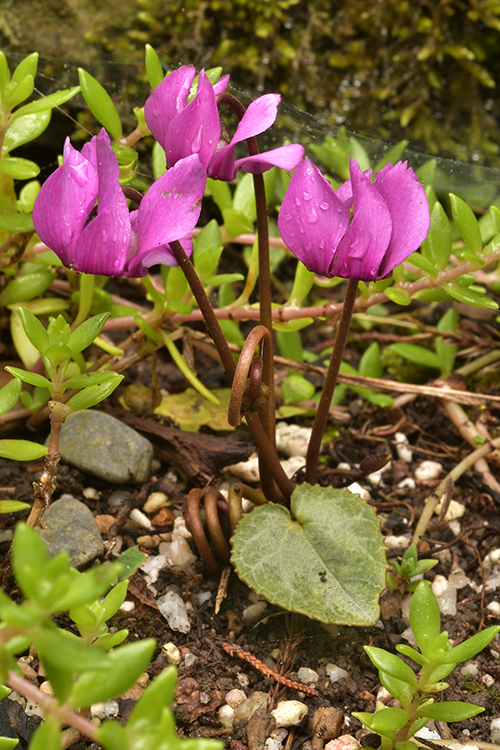
The tubers of Cyclamen hederifolium are among the largest of the genus with some growing to dinner plate dimensions of 10" in diameter! The brown, circular tubers are usually flattened, with the upper surface depressed into a cup. The roots appear on the tops and the sides of the tuber, indicating that it originated near the base of the hypocotyl stem and the tissue is more root-like. When planting the tubers, place them so the top is roughly 1" below the soil and at a slight angle, preventing water from accumulating in the cup. It is native to woodlands as well as shrubby and rocky regions from Southern France to Eastern regions of Turkey, including many Mediterranean Islands. The plants look great worked into woodland gardens, especially near the edge of trails. The plants appreciate drier soils during the summer months and they are amazingly hardy, flourishing in zones 5–9.
A much smaller growing species that has proven to be successful and nearly evergreen in NJ is Cyclamen purpurascens, commonly called the Alpine Cyclamen. Native from Eastern France to Poland south to Slovenia, Bosnia and Herzegovina, the plant was named in 1768 by the English botanist Phillip Miller (1691–1771). The species epithet pays homage to the color of the flowers as it is from the Latin verb meaning to 'become purple'. The flowers appear in mid to late July in colors of pale rose pink to the more typical rosy purple as seen in Picture 5. Each petal is ½–¾" in length and is slightly twisted, providing a very dramatic display. Unlike its cousin, the flower petals do not have pronounced auricles. The flower display lasts around 3 weeks, much shorter than its cousin, yet providing color when many other woodlanders are quiescent. Interestingly and like its cousin, the seeds do not ripen until the following July although it flowers many weeks earlier!
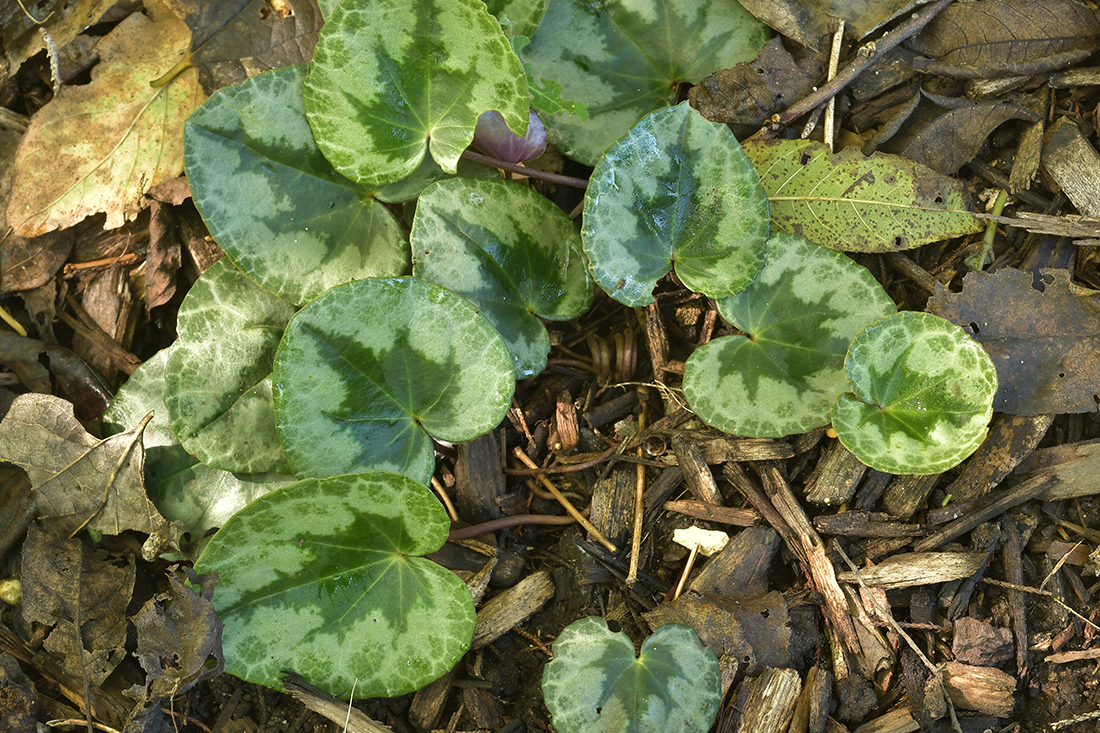
Remaining green through winter, the foliage of Cyclamen purpurascens varies from heart-shaped to rounded, with either a smooth or lightly toothed leaf margin (Picture 6). The new leaves appear in late June, just prior to and during the onset of flowering. Foliage varies in color from nearly all green to all silver, although silver mottling is the most common. Often, the silver mottling surrounds a central green splotch that bears a strong resemblance to that of a maple leaf (Picture 6)! The tubers are far smaller than those of its previously mentioned cousin, reaching a mere 2+" in diameter and more globose in shape. The roots appear on the sides and bottoms of the tuber, showing the tuber develops closer to the cotyledons than the roots.
In their native regions, the plants frequently grow in shady Beech woodlands on limestone soils with a slightly alkaline pH. If your soil is acidic, provide them with occasional topdressings of limestone to help maintain a sweeter pH. As before, plant them in a woodland garden adjacent to a path where the details of the leaf and flower can be appreciated during a summer stroll. Unlike most Cyclamen, Alpine Cyclamen does not enter dormancy or if so, it is for a very short period in late June. As a result, they resent dry soil and benefit from a soil amended with moisture retaining compost. Plants grow best in zones 5–9.
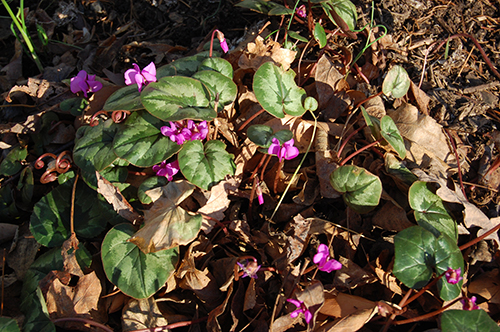
Cyclamen coum is another species that is easily grown in NJ, providing it is allowed to self-sow. The species was once again named and described by Miller in 1768 and the species epithet probably refers to the area known during biblical times as Quwê, a province located near present day Adana in Turkey. The plants are native to Bulgaria, south and east through Turkey, Georgia and Syria into northern Iran. The round tubers are 2–2½" in diameter with the roots emerging from the center of the base. I have found the tubers to be relatively short-lived in NJ, but the colonies will expand and perennialize through the production of seedlings. The leaves are more rounded than the other species, with a deep green leaf color and silver mottling. The leaves often display the classic maple leaf outline in the center of the leaf. The foliage appears during the fall and remains throughout the winter before entering dormancy in mid to late spring. Flowers appear in late winter and are typically magenta as seen in Picture 7, although pink and white forms also exist. Flowers of this species lack auricles and as is typical of species lacking these 'ears', the floral cup or opening is smaller. Hardy in zones 5–8, it thrived in Hawthorne NJ, enjoying a steeply sloping and well-drained site where it would bloom in late winter, accompanied by Snowdrops and Winter Aconites.
There is no shortage of additional species of Cyclamen that the ardent gardener can add to their landscape, although many are more appreciative of container culture and overwintering in a cool greenhouse. Obviously, the various species of hardy Cyclamen offer a far longer period of color and interest than its nonhardy cousin, highlighting why this genus should not be pigeonholed as merely a houseplant. This fall, take notice of these wonderful plants in bulb catalogues, garden centers or on-line and add several selections of 'Dancing Cyclamen' to your woodland garden!
